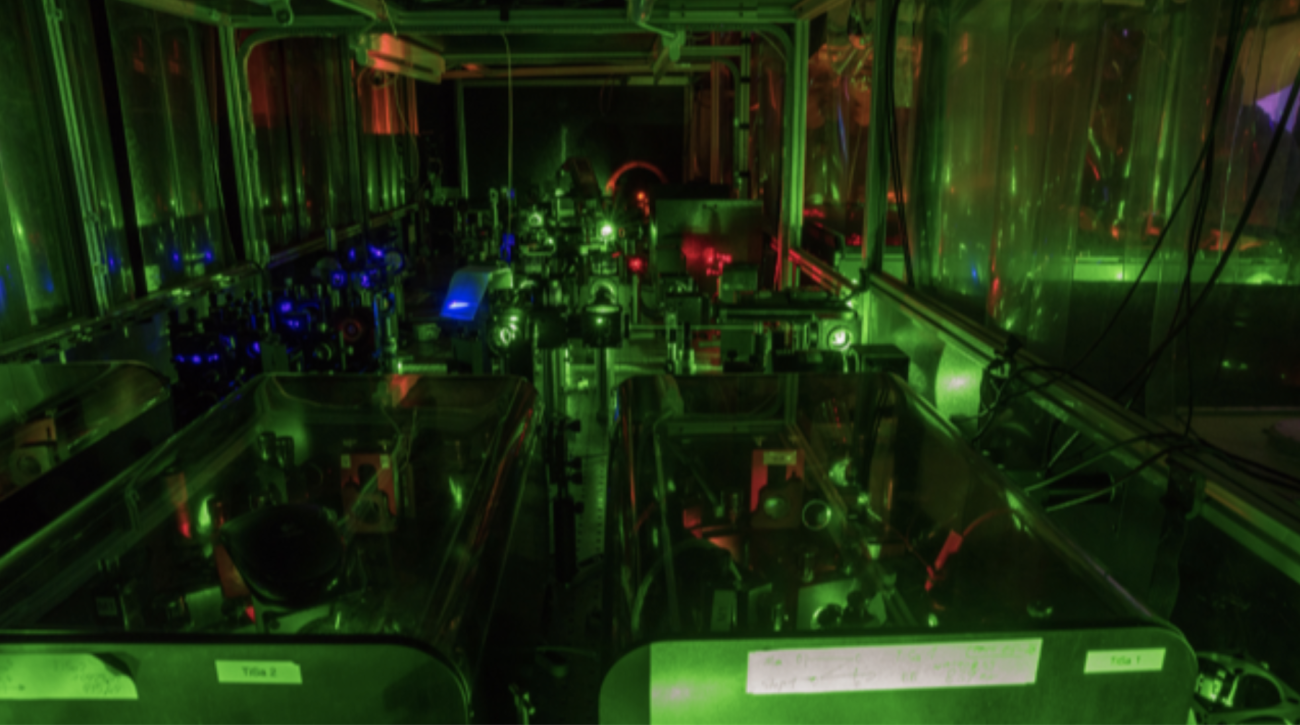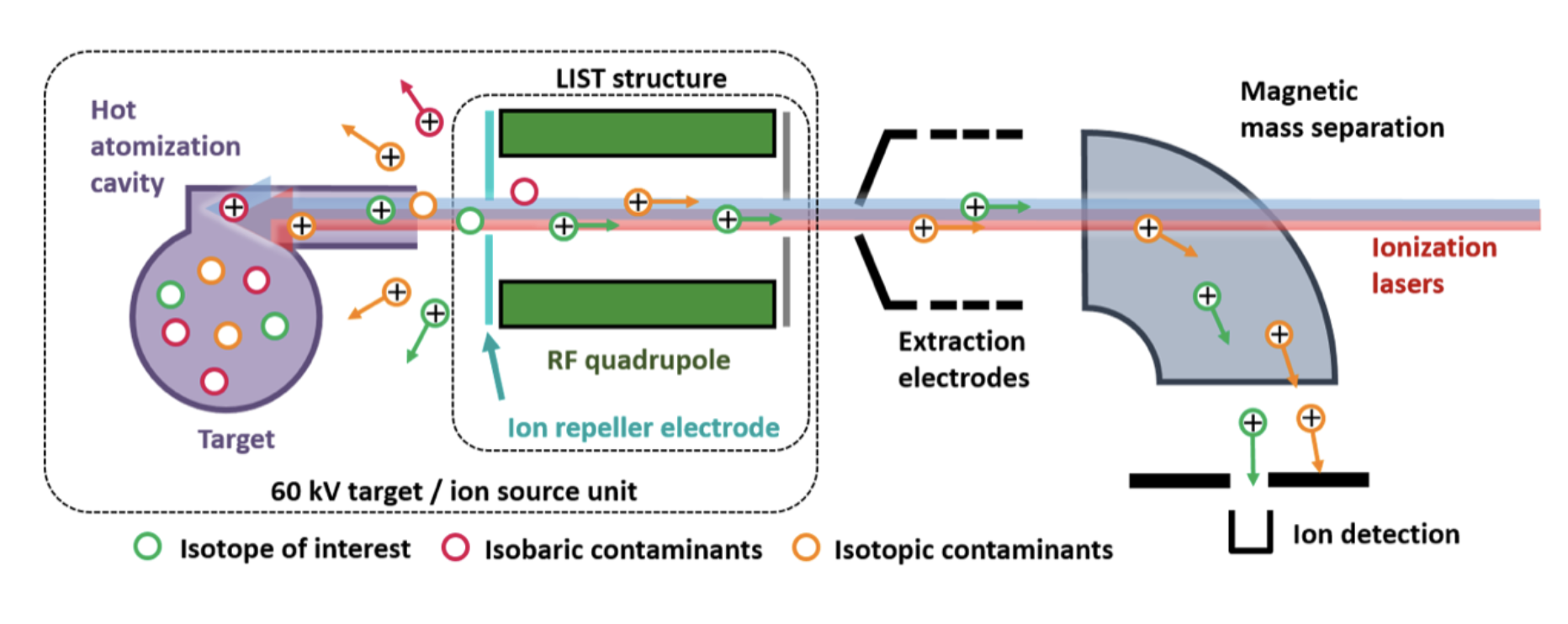The LISA project at CERN-ISOLDE

The LISA (Laser Ionisation and Spectroscopy of Actinides) consortium aims to train a new generation of experts in radioactive ion beam research and applications, laser spectroscopy, scientific laser technologies and atomic theorists whilst they work towards the goal of vastly improving our understanding of the atomic and nuclear properties of the chemical elements known as the actinides (atomic number Z ≥ 89).
To this end, the ISOLDE facility at CERN provides experiments with a wide range of isotopes across the nuclear chart, produced in reactions from 1.4 GeV protons with thick targets. The capability to produce radioactive elements such as the actinides makes CERN’s isotope factory a key player in the LISA project. In one of the milestones of the LISA project, the PI-LIST (Perpendicularly Illuminated Laser Ion Source Trap) [1] made its long-awaited debut at ISOLDE this year. A small radio-frequency (RF) quadrupole ion trap provides radial confinement for a field-free ionization region inside the LIST structure. The hot atomization region is separated from the clean interaction region for element-selective laser ionization, suppressing the non-selective surface-ionized contamination and enhancing ion beam purity by orders of magnitude [2,3]. The addition of perpendicular laser illumination reduces the effective Doppler broadening in the effusing hot vapor, enhancing spectral resolution [4].

Schematic of the ISOLDE Laser Ion Source and Trap (LIST), the successful debut of which is one of the LISA milestones.
The LISA team overcame many setbacks in the past year, concluding with successful coupling of the LIST ion source at ISOLDE and commissioning of the required infrastructure. Two dedicated beam times focused on systematically characterizing the performance of the LIST on the elements indium, ytterbium, tin, barium, and tellurium, as well as evaluating the background suppression in regions of high experimental interest. A major milestone was achieved with the ambitious and collaborative experiment IS664: Investigation of octupole deformation in neutron-rich actinium using high-resolution in-source laser spectroscopy. In May 2022, the team used the PI-LIST at ISOLDE to conduct the first high-resolution in-source laser spectroscopy of actinium, the first of the actinide series. The ISOLDE Decay Station (IDS) experiment joined in with decay spectroscopy, and ISOLDE’s CRIS experiment contributed laser light, sending narrowband cw light from the CRIS laser lab to the RILIS laser lab to seed an injection-locked ring cavity titanium:sapphire laser for high-resolution laser spectroscopy. The successful implementation of the PI-LIST at ISOLDE pushes the resolution of in-source laser spectroscopy below previous limits, enabling the measurement of nuclear physics observables and concluding a major milestone for laser spectroscopy and nuclear physics.

LISA will increase our understanding of the atomic and nuclear properties of the chemical elements known as the actinides. By implementing novel experimental techniques will shed lights on the limits of stability and the evolution of nuclear structure across the nuclear landscape.
Before reaching the ion source, let alone the rest of the experiments stationed at ISOLDE, the elements of interest must be extracted from the thick targets where they are produced. The actinides are refractory, with high boiling points and low vapor pressures. This makes it difficult to extract them from the target material and transport them to the ion source for spectroscopy or further delivery to experiments. At ISOLDE, molecular extraction is occasionally used as a technique to overcome the difficulty of accessing the refractory elements by forming volatile molecules [5,6] of very refractory species such as carbon [7], boron [8] or refractory metals [9]. Delivering the isotopes on a molecular sideband shifts the mass of interest for the mass separator facility, an additional technique to improve beam purity by changing the isobaric contamination. Beyond their use for enhanced extraction, radioactive molecules provide additional opportunities to search for fundamental symmetry violations and new physics beyond the standard model [10,11]. Recent studies of radium fluoride [12] demonstrate ISOLDE’s capability to contribute to searches for fundamental physics as a radioactive ion beam facility.
This year saw the first results of ongoing work on both actinide and molecular ion beams at ISOLDE. In three beam times dedicated to target and ion source development, uranium carbide targets were used to produce atomic actinide and molecular beams via injection of reactive tetrafluoro-methane (CF4) gas. The composition of the ion beams was studied using: the ISOLTRAP Multi-Reflection Time-of-Flight Mass Spectrometer (MR-ToF MS) [13] for identification by ToF mass measurements, online γ-ray spectroscopy at the ISOLDE tape station [14,15], and off-line α- and γ-ray spectrometry of ion-implanted samples. After a year filled with long and challenging target development beam times dedicated to understanding the actinide region and molecular formation, ISOLDE has gained the capability to produce two new beams of the actinide elements neptunium and plutonium [16] as well as new beams of radioactive actinide molecules.
Within the LISA project, ISOLDE’s SY-STI team demonstrated the facility’s capability to produce actinide elements and radioactive molecules for fundamental physics research, and to perform high resolution in-source laser spectroscopy of the radioactive species produced by the facility. The team’s achievements this year conclude some major milestones for the LISA project and push the ISOLDE facility forward as a key player in radioactive ion beam production, studies of the actinide elements, and laser spectroscopy.
Note: This project has received funding from the European’s Union Horizon 2020 Research and Innovation Programme under grant agreement number 861198 project ‘LISA’ (Laser Ionization and Spectroscopy of Actinides) Marie Sklodowska-Curie Innovative Training Network (ITN).
References
[1] R. Heinke, PhD thesis, JGU Mainz (2019)
[2] D. Fink et al., Nucl. Instr. Meth. B, 317 B, 417-421 (2013)
[3] D. Fink et al., Phys. Rev. X 5, 011018 (2015)
[4] R. Heinke et al., Hyperfine Interact 238, 6 (2017)
[5] R. Eder et al., Nucl. Inst. and Meth. B 62, 535 (1992)
[6] R. Kirchner, Nucl. Inst. and Meth. B 126, 135 (1997)
[7] H. Frånberg et al., Rev. Sci. Inst. 77, 03A708 (2006)
[8] J. Ballof et al., Eur. Phys. J. A 55, 65 (2019)
[9] U. Köster et al., Eur. Phys. J. Special Topics 150, 293 (2007)
[10] M. Safronova et al., Rev. Mod. Phys. 90, 025008 (2018)
[11] N. Hutzler et al., arXiv, DOI 10.48550/ARXIV.2010.08709 (2020)
[12] R. Garcia-Ruiz et al., Nature 581, 396 (2020)
[13] R. N. Wolf et al., Int. J. Mass Spec. 123, 349 (2013)
[14] C. Neacşu et al., Nucl. Inst. and Meth. A 1026, 166213 (2022)
[15] R. Catherall et al., J. Phys. G : Nucl. Part. Phys., 44, 094002 (2017)
[16] M. Au et al., in preparation (2022)
